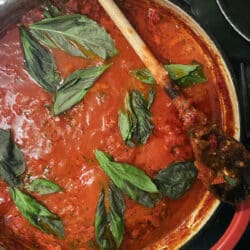
This post may contain affiliate links or sponsored content. That means if you click on my link and buy something, I will earn a small commission from the advertiser at no additional cost to you. For more information on this, please click here.
This Authentic Sugo Recipe is an easy, foolproof Italian Tomato Basil Sauce with loads of flavor that you can enjoy with your favorite pasta or in lots of other dishes. It’s simple, delicious and will become your new go-to recipe that you and your family will love. Once you try this homemade sugo, you’ll likely never return to the store-bought versions!

I grew up eating and making this rich, flavorful tomato sugo recipe. It’s highly nostalgic for me and immediately brings back memories of my mom standing at the stove in our kitchen cooking it and creating memories for our family. It just wasn’t Sunday without the aroma of slowly simmering tomatoes in the house!
Sugo, the Italian word for “sauce”, is a staple in every Italian and Italian-American household. And, in typical Italian fashion, no two are made alike. This meat-free version is what we enjoyed on repeat growing up in southern New Jersey. With a few ingredients that accent the star tomatoes, it is simple to execute and only needs a little bit of time to simmer on the stovetop, creating a thick and luscious, rich tomato sauce that pairs well with pasta and so much more!
This tomato bail sugo recipe is perfect with Homemade Pan-Fried Meatballs, Baked Italian Sausages, Eggplant Meatballs, Baked GlutenFree Meatballs made with oats and Chicken Cutlets and makes the following recipes even better: Sausage Stuffed Cubanelle Peppers and Artichoke Bottoms, One Pot Italian Green Beans in Tomato Sauce and Stuffed Italian Peppers.

What’s the Difference Between Sugo, Marinara, Ragu and Gravy?
Well, it depends who you ask.
I could seriously write a short dissertation about all the different explanations that people have answering the above question. Actually, perhaps two dissertations–one from the Italian-American perspective and one from the Italian perspective. (Because, let’s face it, Italian and Italian-American are two distinct cuisines and culinary points of view, albeit related.)
Some say that marinara is more complex than sugo (i.e., tomato sauce), and some claim the opposite–that marinara is a very quick-cooking sauce, seasoned only with garlic, crushed red pepper and basil, whereas a tomato sugo/sauce is a more complex affair (more akin to what I would refer to as a meatless ragu) that is seasoned with onion, carrot, celery and bay leaf, and left to simmer for hours until thickened and rich in flavor.
And then there’s the question of the origin of the word marinara and of the sauce: “marinaro” is the Italian word for “sailor”, and one theory is that cooks aboard Neapolitan ships returning from the Americas invented marinara sauce in the 1700s after Spaniards introduced the tomato to Europe. Another theory states this was a sauce prepared by the wives of Neapolitan sailors upon their return from sea. (In Italy, marinara is a seafood sauce, whereas in the US, it is a meatless, vegetarian tomato sauce. Adding to the confusion, a marinara pizza is made without fish and is simply a pizza with tomato sauce, garlic, oil and oregano.)
Ragu is generally a very hearty tomato-based sauce containing different cuts of meat that are slowly cooked in it over several hours. Some Italian-Americans call this “gravy “. (But, in our house, gravy and sugo and sauce were all the same–sometimes they were made with meat, and sometimes not. Go figure.)
Whatever you believe, one thing is for sure–tomato sauces in all of their iterations and nomenclature are among the most important staples in la cucina Italiana and every casa, nonna, mamma, cuoco and chef have their own particular way of preparing it (often) with very strong opinions about the procedures, list of ingredients and, of course, the specifics of the tomatoes to be used.
And, they are ALL delicious in their own right.
For a simple tomato sauce recipe using frozen tomatoes, click here!

It’s All About The Tomato . . .
Indeed, this recipe is all about the tomato. Even the freshest basil and best extra-virgin olive oil cannot mask a sub-par canned tomato in the finished sauce.
My culinary goal is always to use the best quality ingredients that I can find (and afford) and then do very little to them. And, this recipe is a great example of that philosophy.
For this recipe, use the best quality canned tomato that you can. Canned tomatoes are picked at the peak of ripeness and then properly packaged, so they are undeniably the easiest and best way to go. My recommendations are as follows:
- Imported Italian tomatoes.
- Whole peeled tomatoes (a.k.a., pomodori di pelati) as opposed to pre-crushed tomatoes or tomato puree as they are less processed.
- Certified San Marzano tomatoes that have the DOP (Denominazione d’ Origine Protetta) label, which basically means that they are the real thing.
These quality tomatoes have less seeds, are naturally sweet and should never need any sweetener added to them.
To read more about the DOP certification process for San Marzano tomatoes, click here.
If you enjoy classic, tomato-based sauces, give this Sugo Recipe a try. It’s reliable, comes together relatively quickly, and is sure to impress even your Italian friends. (I once impressed a native Sicilian with it!)

Ingredients for Tomato Basil Sugo Recipe
The ingredients in this traditional Italian Tomato Basil Sauce are few but significant and are items that you most likely already have on hand. Choose quality ingredients if at all possible.
- Tomatoes: I discuss tomatoes in depth above, but would like to reiterate that I almost always choose to use whole tomatoes as opposed to diced or pureed as they are less processed since they aren’t diced or crushed by a machine. I will then hand crush the tomatoes, resulting in a slightly chunky texture.
- However, if you prefer a smoother sauce, use tomato puree (a.k.a., tomato passata) or crushed tomatoes. Alternatively, use an immersion blender directly in the pot to puree the whole tomatoes.
- Check the Recipe Variations section below for some information about using fresh tomatoes.
- Fresh Basil is used in two places in the recipe–at the beginning to release its fragrant flavors early in the cooking process so that it can be properly infused into the sauce, and layered again at the end to give the sauce a punch of fresh herb flavor.
- Onions and Garlic: These are both significant flavor builders. I suggest finely chopping both the onions and garlic so as to not have any large pieces in the finished dish. And, definitely do not use jarred, pre-minced garlic as it contains additional flavors that are unpleasing. Fresh is best!
- Extra Virgin Olive Oil: Use a great quality olive oil to sauté the onions and garlic.
- Dried Oregano and Crushed Red Pepper: Additional aromatics that contribute to the overall flavor of the dish. Neither of these should be a strong flavor in this recipe, but rather subtle.
A complete and detailed list of ingredients with amounts and instructions is included in the recipe below.

Steps to Make Authentic Sugo Recipe, Pro-Tips included!
Here are the main steps for how to make this classic Italian tomato basil sauce:
- In a heavy-bottomed saucepan or Dutch oven, heat the olive oil and the onions together over medium heat and sauté until the onions are soft (about 5-7 minutes).
- PRO-TIP: Cover the pot for a couple minutes to speed up the softening process, if desired.
- Add the garlic and continue to sauté until the garlic is soft.


- Add the basil and crushed red pepper and cook for two minutes, to release the flavors of the herb, while stirring.
- PRO-TIP: Fresh basil should really be used in this sauce. However, if you don’t have any, you can use 2-3 teaspoons dried basil added to the sauce at the same time as the dried oregano.


- Add tomatoes, water, salt, black pepper and dried oregano and bring to a light boil, then immediately reduce heat to a low simmer. Simmer, partially-covered, for about 45-60 minutes. Adjust seasoning, if necessary.
- PRO-TIP: If you prefer a smoother sauce, use tomato puree or crushed tomatoes. If you use whole or diced tomatoes in juice (as opposed to sauce), either cut back on the amount of water added by 25% or simmer and reduce until your desired consistency.


- Remove from heat and stir in the second amount of basil and the sauce is ready to go! Sauce can be held in an air-tight container in the refrigerator for up to 7 days or in the freezer for 3-6 months.
- PRO-TIP: This recipe makes about 12-13 cups sauce. The recipe can be cut in half or doubled, based on how much sauce you need.

Frequently Asked Questions
Here are answers to some frequently asked questions about this salsa pomodoro:
This recipe is all about the tomato. Even the freshest basil and best extra-virgin olive oil cannot mask a sub-par canned tomato in the finished sauce.
For this recipe, use the best quality canned tomato that you can. My recommendations are as follows:
–Imported Italian tomatoes.
–Whole peeled tomatoes (a.k.a., pomodori di pelati) as opposed to pre-crushed tomatoes or tomato puree as they are less processed.
–Certified San Marzano tomatoes that have the DOP (Denominazione d’ Origine Protetta) label, which basically means that they are the real thing.
These quality tomatoes have less seeds, are naturally sweet and should never need any sweetener added to them.
If you prefer a smoother sauce, use tomato puree (a.k.a., tomato passata) or crushed tomatoes. Alternatively, use an immersion blender directly in the pot to puree the whole tomatoes.
And, if you use either whole or diced tomatoes in juice (as opposed to sauce), either cut back on the amount of water added by 25% or simmer and reduce until your desired consistency.
I know that it’s popular for many to add a little sugar to their sauce to sweeten it and offset the acidity and occasional bitterness of canned tomatoes. You certainly can add a little sugar if that is what you are accustomed to.
But, as a purist (most of the time), I have never added sugar to any homemade tomato sauce, ragu, gravy, sugo or marinara. If I notice that the flavor of the underlying tomatoes is overly acidic, I’ll add a couple of carrots to the simmering sauce, cut into big chunks that can easily be removed. Carrots are naturally sweet and generally have the same sweet result as adding sugar.
Also, a higher quality canned tomato will likely not require any added sweetener.
Fresh basil should really be used in this sauce. However, if you don’t have any, you can use 2-3 teaspoons dried basil added to the sauce at the same time as the dried oregano. For the best results, use fresh basil at the end of the recipe in the finished sauce.
Absolutely! I do this practically every time I make sugo, as it freezes beautifully. I will double (at least) the recipe, then freeze it in strategically-sized portions for future cooking. In an airtight container in the freezer, this sugo recipe will last 3-6 months.
This depends on how saucy you like your pasta. It also depends on the shape and texture of the pasta, as some shapes and textures absorb more sauce than others.
Having said this, in my humble opinion a good rule of thumb to follow is about 3 cups tomato sauce for every pound of pasta. So, I generally will freeze this sugo recipe in quart containers to have it perfect for 1 pound pasta (with a little leftover).
The recipe below is for a large batch of sauce and yields about 12-13 cups. You can easily either halve or double the recipe as needed.
This recipe is not meant for canning. For more information about preparing tomato sauce for canning, check out this link.

Recipe Variations for Authentic Sugo Recipe
This Authentic Sugo Recipe without Meat is a basic and classic, simple tomato sauce. Still, there is always room for a little variety in the recipe. Here are a few ideas:
- Add some fresh parsley along with the basil at the beginning of the cooking process for a more intense herb flavor.
- Deglaze the pan with some dry white or red wine before adding the tomatoes, while scraping up any brown bits (i.e., extra flavor) on the bottom of the pan. The wine will add a nice, well-rounded depth of flavor to the sauce.
- Increase the heat: Double or triple the amount of red pepper flakes or add some Calabrian chile paste at the beginning of the cooking process (or both) for increased heat.
- Use fresh tomatoes instead of canned–a great option in summer when fresh, ripe, juicy tomatoes are in abbondanza. Red plum or roma tomatoes are a great option. For best results, fresh tomatoes will need to be blanched in boiling water, shocked in ice water, and then peeled before using, and some tomato paste may need to be added as well.
Serving Suggestions and Storage Information
There are so many great uses for this great Sugo Recipe beyond using it as a sauce for pasta.
I love to have extra on hand in the freezer so that I can use it in a pinch to make parms and parm subs of all sorts (chicken, eggplant, sausage, meatball), eggs in purgatory, quickly throw together baked ziti, lasagna or eggplant rollotini or, frankly, use it as a dip for crusty bread to create a simple meal on its own.
Store Sugo Recipe leftovers in an airtight container or jar in the refrigerator for about one week. This sauce also freezes beautifully and can be frozen in properly sealed freezer-safe containers or bags for three to six months. Consider freezing it in 3-4 cup portions–the perfect amount for one pound of pasta!

More Homemade Italian Favorites
Check out these Italian American classics:
- Easy Homemade Meatballs
- Pasta e Piselli (Pasta with Peas)–savory, easy and delicious!
- Pasta with Chickpeas–classic cucina povera
- Greens and Beans (Escarole and Beans)–hearty and nutritious
- Pasta with Broccoli–beloved by all!
Kitchen Tools & Cookware Needed
To make this authentic Italian tomato sauce recipe, you’ll need the following:
- Cutting board with non-slip mat underneath (I use shelf liner)
- Sharp chef’s knife
- Measuring cups and spoons
- Multiple bowls to hold prep
- Garlic press
- Dutch oven or large pot
- Wooden or silicon spoons

More Great Recipes to Try
I hope that you are enjoying Mangia With Michele and all of my Italian and Italian-American recipes!
If you’ve tried this Sugo Recipe, please let me know how it went in the comments below. I love hearing from you!
FOLLOW ME on FACEBOOK and INSTAGRAM to see more delicious food and what might be going on behind the scenes!

Authentic Sugo Recipe without Meat (Italian Tomato Basil Sauce)
Ingredients
- ⅓ cup extra virgin olive oil
- 2 cups finely chopped yellow onions
- ¼ cup finely chopped garlic
- 1 cup sliced or hand-torn fresh basil, lightly packed (can also leave the leaves whole)
- ½ tsp crushed red pepper
- 4 (28-ounce) cans whole tomatoes, crushed by hand + 1 can water
- 2 tsp salt (or to taste)
- ½ tsp black pepper (or to taste)
- 1 Tbsp dried oregano
- Large handful fresh basil leaves, whole or torn by hand
Instructions
- In a heavy-bottomed saucepan or Dutch oven, heat the olive oil and the onions together on medium heat and sauté until the onions are soft (about 5-7 minutes). Cover the pot for a couple minutes to speed up the softening process, if desired.(Please see the section above in the blog post for Step-By-Step instructions with photos.)⅓ cup extra virgin olive oil, 2 cups finely chopped yellow onions
- Add the garlic and continue to sauté until the garlic is soft.¼ cup finely chopped garlic
- Add the basil and crushed red pepper and cook for two minutes, to release the flavors of the herb, while stirring.1 cup sliced or hand-torn fresh basil,, ½ tsp crushed red pepper
- Add tomatoes, water, salt, black pepper and dried oregano and bring to a light boil, then immediately reduce heat to a low simmer. Simmer, partially-covered, for about 45-60 minutes. Adjust seasoning, if necessary.4 (28-ounce) cans whole tomatoes,, 2 tsp salt, ½ tsp black pepper, 1 Tbsp dried oregano
- Remove from heat and stir in the second amount of basil and the sauce is ready to go! Sauce can be held in an air-tight container in the refrigerator for up to 7 days or in the freezer for 3-6 months. Buon Appetito!Large handful fresh basil leaves,
Notes
- Fresh basil should really be used in this sauce. However, if you don’t have any, you can use 2-3 teaspoons dried basil added to the sauce at the same time as the dried oregano.
- If you prefer a smoother sauce, use tomato puree or crushed tomatoes. Diced tomatoes can also be used. If you use either whole or diced tomatoes in juice (as opposed to sauce), either cut back on the amount of water added by 25% or simmer and reduce until your desired consistency.
- The best part of this sugo is that you can start with this basic recipe and tweak it to your personal preferences of heat, sweetness and thickness. The longer it cooks, the thicker and more fragrant it gets!
- This sugo freezes really well! Freeze it in an air-tight container for 3-6 months.
- This recipe makes about 12-13 cups sauce. The recipe can be cut in half or doubled, based on how much sauce you need.








Yummy! Delicious and oh so wonderful with Michelle’s amazing meatballs. Many tomato based sauces leave you with awful heartburn, but not this one. Just perfect.
I agree. Rao’s sauce always gives me heartburn. Michelle’s doesn’t. Enough said.
Hello Michele, I tried your hot pepper oil and loved it. My mom 100% Italian would make the fastest most delicious red pasta sauce. She would heat up about 2 tablespoons of olive oil, grate one small onion very fine, add fresh chopped garlic, heat it in a cast-iron skillet, then fry a medium size can of tomato paste. Once the paste got brown, she would add same size can hot water, heat to boil, then throw 1-2 Tablespoons of sugar, crushed fresh basil, oregano, fresh parsley and 2 more cans of hot water and stir for about 30 minutes. This is the best tomato sauce I ever had. Thank You!
Thanks so much for your comment, Deborah! I’m so happy that you enjoyed the hot pepper oil and tomato sauce recipes.
Can the sauce be made in a slow cooker?
Sounds delicious.
Thanks, Luci! This recipe was not written specifically for a slow cooker and I have not tested it in a slow cooker. Having said this, please let me know if you do, indeed, try it out that way.
Amazing sauce- simple and so delicious! I paired it with fresh shrimp scampi and calamarata pasta and the combo was incredible! Plus I had extra sauce to freeze for the next time!
Love your pairings, Barbara! Glad you had some to freeze for next time. 🙂
This recipe turned out perfectly and I loved that it was a larger batch to have a bunch to freeze.
Glad you enjoyed the recipe!
This recipe is delicious ! I made it for my family everyone loved it . I will be making this always and forever. Thank You !
I’m SO happy that you love this recipe, Carrie! Thanks for your comment. 🙂